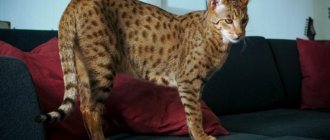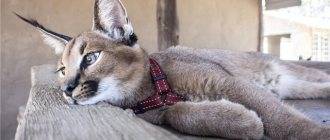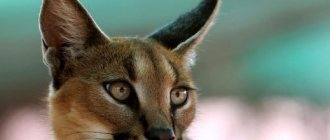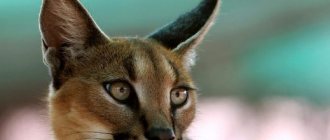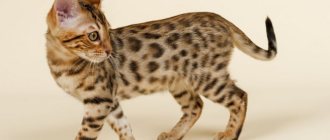Those who consider the caracal a wild animal are right. People who consider him a pet are not mistaken either. Caracals are unique representatives of the cat family. You can see them both in natural conditions and in homes. Domestic caracals are classified as exotic cats; there are not too many owners of such pets.
Man did not have to breed this breed of cat; nature did it for him. Caracals live in African and Asian territories, where forests and steppes border, in the areas of the Caspian coast. Animals do not like arid deserts; they prefer steppe plains, where their color allows them to remain unnoticed. Caracals coexist peacefully with servals, but their relationship with cheetahs does not work out.
This is a nocturnal predatory animal. Wild cats move freely along tree branches, can swim, run fast, and their jump length exceeds 4 meters. This allows them to easily overtake any prey. Caracals are not limited to inhabitants of fields and forests; they do not refuse to feast on small livestock. Therefore, they were actively hunted, turning wild cats into an endangered species. The opening of wildlife sanctuaries and nature reserves made it possible to save animals.
The ability to domesticate allowed caracals to become pets. But don’t think that you can calmly pick up a wild kitten and bring it into your home. Such an animal retains its hunting habits, lacks the habits of a domestic cat, or the desire to be affectionate or communicate with humans. Only a caracal cat from a home nursery can please you with its docile character.
[advertising]
The name of these animals takes its roots in the Turkish language. The word "karakalak" is translated as "black ears". This is a kind of calling card of the animal. The caracal has large black ears with sharp tips, on which there are tassels.
Description of the external features of the Caracal cat:
- the head is small in size with an elongated muzzle with white and dark spots;
- large ears set high, black in color, tasseled at the tips;
- the eyes are almond-shaped, yellowish in color, edged with a black stripe;
- the body is muscular, slender, 65-85 cm long;
- height at withers about half a meter;
- paws are slender, of medium length;
- the coat is short, dense, thick;
- the tail is movable and long.
On average, the weight of an adult caracal ranges from 15-20 kg. But there are larger individuals, whose weight can reach 25 kg.
The color of caracals includes the whole range of brown colors. The most common color is sandy. The belly is light, maybe almost white with round spots.
History of the origin of caracals
The name "caracal" comes from the Turkish word "karakulak", which means "black ears". The breed appeared independently in natural conditions; man did not make an effort to create this unusual breed.
The homeland of cats is considered to be Central Asia, Central Africa and the Arabian Peninsula. Individuals live in savannas and lowland areas. Their cohabitants are considered to be a family of servals.
Caracal lives in the savannah
People began to domesticate caracals back in Ancient Babylon in the 3rd-4th centuries. BC. During their research, archaeologists discovered evidence such as images of caracals with lions and cheetahs in carts in paintings, frescoes and household and luxury items.
The caracal is a steppe lynx that can climb trees, run fast, jump high and swim well. Often individuals were taken with them on hunts, where they caught antelope, birds, and hares. The breed loved to hunt livestock, which led to intensive extermination of individuals. However, people soon came to their senses and began to protect the animals. There are 9 subspecies of the breed in total, some of them are very rare, so the cats are protected in nature reserves and nature reserves.
In Russia there are no more than 100 caracals. It is very difficult to meet them. They live in the foothills of Dagestan. Cats are unsociable and prefer to live in the wild. However, man began to tame caracals. Now cats can live at home, where there is a lot of space.
Where to buy a caracal kitten
Do not purchase a pet from dubious places, even if kittens are offered at an attractive price for you. Often sick animals are sold without documents or certificates. In addition, wild babies can be sold in this way. Contact professional breeders at nurseries.
Everyone who wants to get such a pet wants to know how much such a kitten costs. This is an exotic cat, so purchasing it will require significant costs: the price in Russia is about 450 thousand rubles, the price in Ukraine is about 210 thousand hryvnia.
Appearance of a caracal
The caracal is a slender cat with well-developed muscles. Externally, the animal looks like a lynx. The body length is 65-82 cm, the tail is 25-30 cm, the height at the withers is 45 cm. The individual is large in size, its weight can reach 30 kg, which is 8 times less than the average body weight of cats. The caracal has long legs and sharp claws. The front legs are more powerful and stronger than the hind legs. Coarse hair grows on the paws, which allows the predator to move at high speed. The photo shows what the caracal breed looks like.
Appearance of a caracal
The breed has a short muzzle on which are tufted ears. They have elongated black tufts in the form of tassels, which is why the cat is called the steppe lynx. Caracals need these bundles for several purposes. Tassels help keep flies away from your face and help predators camouflage themselves in the grass. Bunches are also needed when communicating with other individuals.
Their expressive eyes are almond-shaped. The color can be either gold, copper, or green, gray.
Caracal with gray eyes
Popular caracal colors
The caracal has only recently been considered a pet, so the number of coat colors has not yet been established. There is no difference between the colors of domestic and wild cats. The difference is that tamed pets have shinier fur than wild animals. Domestic cats eat more regularly and nutritiously, so their hair looks silkier.
The length of the coat is 4-9 cm. Their fur is dense and thick. The following types of colors are distinguished:
- Light brown
- Honey
- Reddish brown
Caracal with light brown color
Males are usually darker than females. The belly of females can even be white, while in males it is no lighter than sand color.
Character and habits of caracals
The character of the caracal is more like a dog than a cat. These are real hunters who love to run, jump, and swim. Natural conditions have made caracals hardy and extremely active.
Since the breed began to be domesticated, domestic Caracal cats have become more affectionate and friendly. If raised correctly from childhood, the pet will become a faithful and devoted friend who will protect its owner.
Caracal - a loyal breed
This unusual breed should not be owned by families with small children. The caracal does not show aggression unless provoked, so it is better to wait until the child is older.
Individuals need a lot of space. They live well in houses with an aviary or in country houses. The apartments will be cramped for caracals.
Caracals are cramped in small apartments
Breeding and care
The caracal is an active, large animal; it needs movement and periodic walks in the fresh air. If your home has an enclosure, you can leave your cat in it for a certain period of time. Otherwise, you will have to walk your pet on a harness. The caracal easily gets used to this restriction. Walking near dog walking areas is prohibited. A cat can attack a dog, even if the dog is stronger.
[advertising-text]
Caracals are easily litter trained. The toilet should be located in a secluded place, as far as possible from frequently opening doors and active areas. A deep tray is filled with wood pellets or silica gel. The contents need to be changed every day.
The pet will shed all year round; in the summer months this process intensifies. The cat needs to be periodically cleaned with rubber brushes; you can put a silicone glove on your hand, rub it over all parts of the body, and remove hairs. The tips of the claws should be removed periodically with round pliers.
Caracals love swimming. Periodically you need to give them a bath with hypoallergenic cat shampoo. From spring to autumn, cats should wear flea collars. It is necessary to regularly carry out prophylaxis against worms and receive mandatory vaccinations prescribed by a veterinarian. If mating or breeding of animals is not planned, it is necessary to promptly castrate the male and sterilize the female. During sexual activity, the behavior of these animals can become unpredictable, and aggression is possible.
How long does a caracal live?
These animals have excellent immunity; they have no specific diseases. Provided that your pet is properly maintained, your domestic cat will remain cheerful, cheerful, and active until the age of 15-16 years.
Health
The breed is considered a long-liver; in the wild, individuals live 13-15 years, and in domestic conditions - 18-20. Nature has made animals strong and resilient, so cats have good health and strong immunity.
Caracals do not tolerate cold well because their habitat is hot savannas, deserts and steppes.
To avoid many diseases, pets need to be vaccinated 2 times at the beginning of life. At 10-12 weeks you need to get a polyvalent vaccination against several diseases, and at 12-13 weeks - against rabies. You can also vaccinate against panleukemia, rhinotracheitis, and calcevirosis.
Health of the domestic caracal
Caracal cats have a fairly strong immune system and are not prone to any genetic diseases. The main thing is to regularly take your four-legged friend for examination by a veterinarian and carry out timely vaccinations. Remember that the caracal is a rather rare and exotic breed. Therefore, treating them at home and using advice from the Internet is not the best idea.
Content Features
The breed is recommended for those who live in large country houses with a spacious enclosure. Cats are extremely active, so they need a lot of space. The pet will feel cramped in the apartment. He can chew or scratch furniture, break valuables. To prevent the caracal from chewing the furniture, you need to buy a scratching post.
Cat toys are not suitable for this breed. They are too small for this beast. It is better to buy small toys for dogs; children's toys are also suitable.
It is important to pay attention to coat care. Shedding continues throughout the year, and in summer hair loss intensifies. Your cat may swallow hair while washing itself, which can obstruct its digestive tract. The pet needs to be brushed with a furminator once a week. As the nail plate grows, you need to cut the nails with a nail clipper. This procedure can be done by a veterinarian.
Dog toys are suitable for caracals
Sometimes it is worth cleaning your ears and eyes with cotton swabs.
Breeding
Caracals are solitary by nature. They form pairs for a short period during the mating season. Pregnancy lasts 76-81 days. Usually 2-3 kittens are born. In the first days after birth, the female does not leave the den and protects her cubs. Usually the mother hides the babies in a hollow or hole to keep them safe.
For the first 10 months, babies live with a cat.
For the first 10 days, kittens are blind. After 4-5 weeks, the kittens begin to go out for a walk under the supervision of their mother. At first they feed on colostrum, and at the age of 2 months they are introduced to solid food. Kittens live with their mother for 10 months, and then move on to adulthood.
Caracals in nature
In nature, caracals are found in savannas, deserts, steppes and foothills of Africa, the Arabian Peninsula, Asia Minor and Central Asia, and the Middle East. Cats live in rock crevices, sometimes occupying empty holes of other animals. Caracals are active mainly at dusk or at night, but they can also hunt during the day.
The peculiarity of caracals is that they can go without water for quite a long time, obtaining liquid exclusively from food. They, like cheetahs, use tall trees to store food. Caracals drag and hide food on a branch, hiding it from the eyes of other predators.
Caracals breed throughout the year. The female has up to 3 partners during the courtship period. Pregnancy lasts 78-81 days, and then up to 6 babies are born. A month after birth, when the babies begin to go out into the sun, the mother begins to move the kittens from one den to another once a day. Six months later, teenagers will leave their parents' home and find a new refuge.
Caracal food
The caracal cat is a predator. The wild animal is accustomed to hunting and eating its prey. They catch hares, birds, antelopes and other rodents. The caracal's diet should be balanced and include all the nutrients this big cat needs.
Caracal eats animal food
List of things you should not feed your cat:
- Salt
- Sugar
- Spices
- Sweets
- Pork
It is advisable to feed individuals with meat with bones. The diet may consist of wings, thighs, drumsticks, veal, lamb and rabbit. Dry food is not suitable for feeding carnivores because it does not contain enough protein, vitamins and minerals. It is advisable to feed your pet natural food, but sometimes you can treat it with dry supplements. It is important to always refill the bowl with fresh water.
To maintain normal digestion and microflora, you need to introduce live food with fur and feathers into your diet.
The first three years after birth, you need to introduce supplements and vitamins into your diet, which contain a full range of micro- and macroelements. There is no need to set feeding frequency for the caracal. Pets are fed 1-2 times a day at different times. The cat should not get used to a certain schedule. And sometimes you can do fasting days so that the animal gets hungry.
The feeding rate depends on the age and size of the pet. The share of meat in the diet is 3-5%. In summer you can feed less often, and in winter more often.

